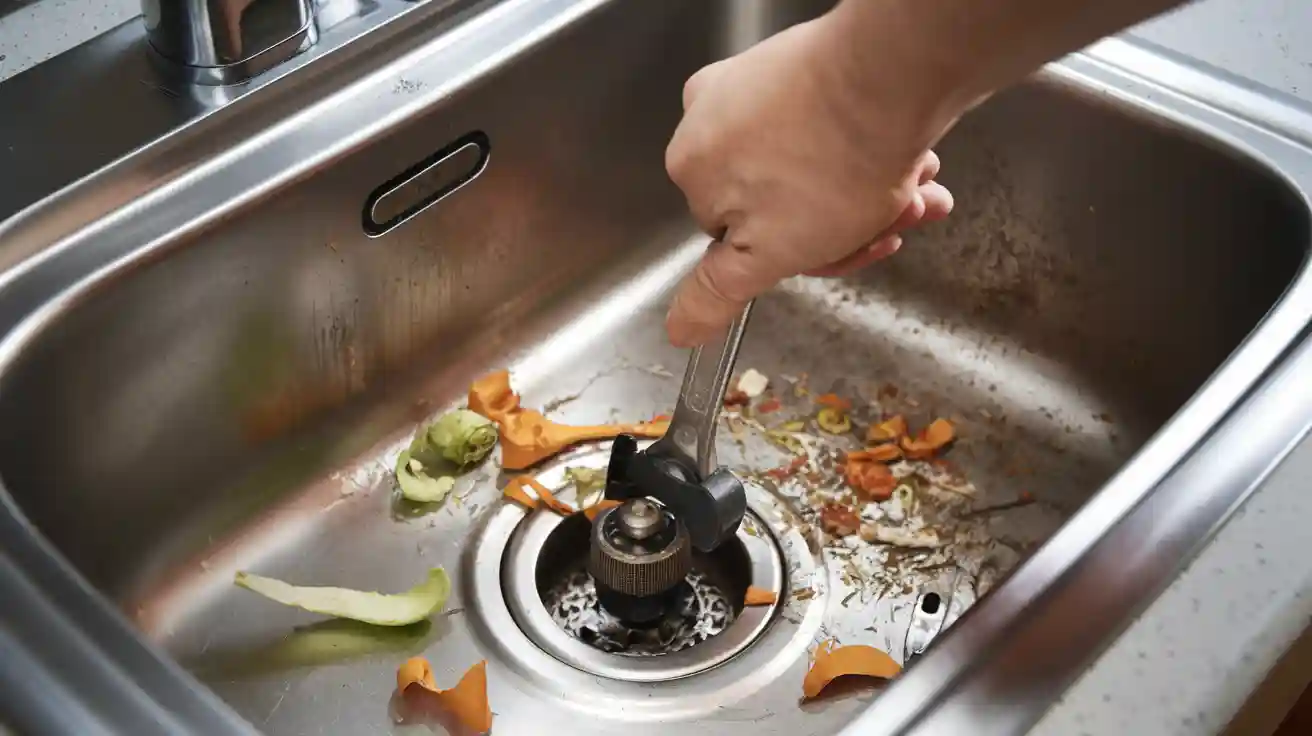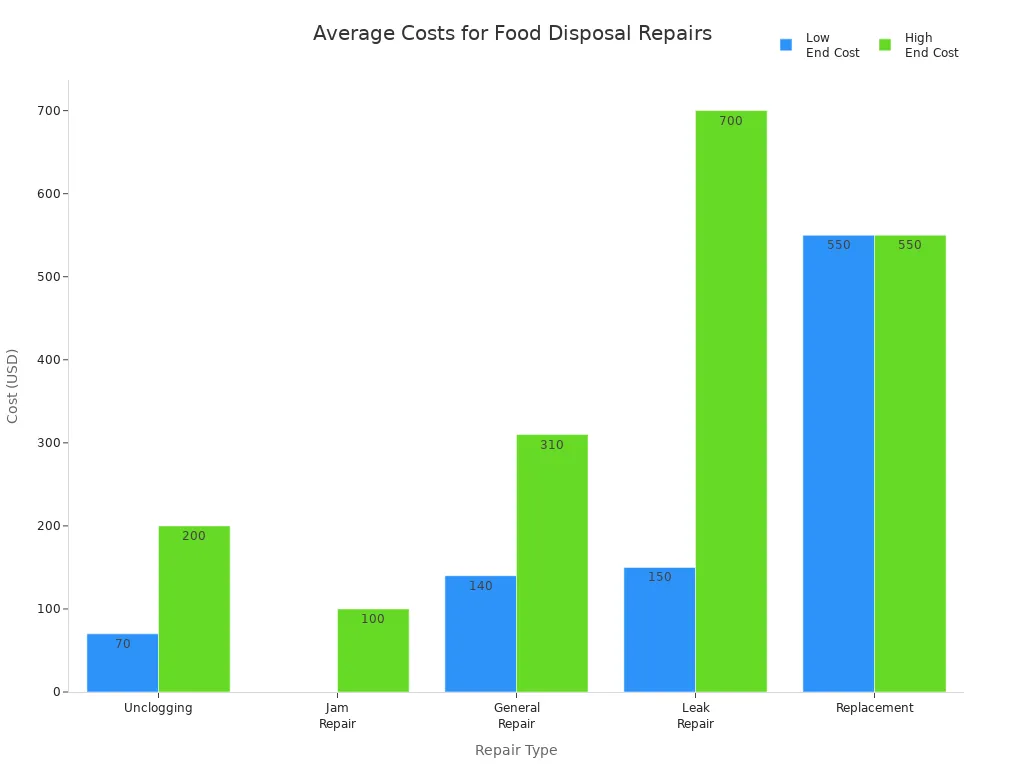
When your food disposal clogged up, stay calm. Before trying any emergency fix, unplug the garbage disposal. Watch out for these risks:
- You might get a serious cut from the blades.
- Water and wires mean electric shock is possible.
- A clog can cause septic overflow or even motor damage.
Emergency Fixes for a Food Disposal Clogged Problem
Turn Off Power to the Garbage Disposal
Before you do anything else, make sure you turn off the power to your garbage disposal. This step keeps you safe from electric shock and prevents the blades from moving while you work.
- Unplug the unit from under the sink if you see a plug.
- If your disposal is hardwired, flip the switch at your electrical panel to cut the power.
Tip: Never put your hand inside the disposal, even when the power is off. Always use tools to reach inside.
Remove Visible Obstructions from a Clogged Garbage Disposal
Sometimes, you can spot the problem right away. If you see food scraps, utensils, or other objects stuck in the disposal, you can try to remove them.
- Make sure the power is off.
- Use tongs or needle-nose pliers to grab and pull out any visible items.
- Avoid using your hands, even if you think it’s safe.
This method works well for a food disposal clogged by large pieces of food or foreign objects.
Use a Plunger for a Backed-Up Garbage Disposal
A plunger can help you unclog a kitchen sink when the garbage disposal backs up.
- Choose a flat-cup sink plunger, not a toilet plunger.
- Fill the sink with a few inches of water to create a good seal.
- Place the plunger over the drain and pump up and down several times.
- Check if the water drains after a few tries.
If the water starts to move, you may have cleared the clog. If not, you can try another method or repeat the plunging process. Plungers work best for minor clogs in a backed-up garbage disposal.
Note: If plunging does not work, you can try a natural cleaner like baking soda and vinegar before calling for emergency help.
Baking Soda and Vinegar Solution for a Clogged Garbage Disposal
You can use a simple kitchen solution to unclog your garbage disposal.
- Pour about half a cup of baking soda into the disposal.
- Add one cup of vinegar.
- Cover the drain with a stopper or a plate to keep the fizzing action inside.
- Wait 5 to 10 minutes for the reaction to break up the clog.
- After the fizzing stops, flush the disposal with hot water.
This method can remove up to 90% of buildup if you let it sit for at least 30 minutes. It’s a gentle way to unclog without using harsh chemicals.
Manually Free the Blades with an Allen Wrench
If your garbage disposal hums but does not spin, the blades might be jammed.
- Make sure the power is off.
- Find the hex socket at the bottom of the disposal unit.
- Insert a 1/4-inch Allen wrench into the socket.
- Turn the wrench back and forth to loosen the jammed impeller plate.
If you don’t have an Allen wrench, you can use a wooden spoon handle through the drain opening to move the blades. After you free the blades, press the reset button on the bottom of the unit.
Flush the Garbage Disposal with Hot Water
After you try other methods, run warm or hot water through the disposal for about one minute. This step helps wash away any loose debris and keeps the blades clean.
- Use hot water only after you finish grinding and cleaning.
- Do not use hot water while the disposal is running, as cold water works better for grinding food.
Hot water helps prevent corrosion and keeps your garbage disposal fresh.
Test and Reset the Garbage Disposal
Once you finish all the steps above, it’s time to test your garbage disposal.
- Plug the unit back in or turn the power back on at the breaker.
- Press the red reset button on the bottom of the disposal.
- Turn on the water and run the disposal for a few seconds.
If the disposal works and the water drains, you have fixed the problem. If it still hums, trips the reset button, or stays clogged, you may need to call a professional.
Here’s a quick table showing why you might need to reset your garbage disposal:
| Reason for Reset | Explanation |
|---|---|
| Motor overload or overheating | The internal breaker trips to protect the motor from burnout. |
| Loose wiring | Incorrect or loose wiring can cause frequent resets, especially in new units. |
| Aging or weakening motor | A motor that needs frequent resets may be worn out and need replacement. |
| Clogs from food waste or debris | Jams can cause the motor to overload and trip the reset button. |
If you keep having to reset your disposal, the problem could be more serious than a simple clog.
Troubleshooting a Clogged Garbage Disposal

If the Garbage Disposal Hums but Won’t Spin
You flip the switch, but your garbage disposal just hums. This usually means the motor gets power, but the blades cannot move. Most times, jammed blades or stuck debris cause this problem. Sometimes, the motor overheats or the wiring gets loose.
Try these steps:
- Turn off the power to the garbage disposal.
- Shine a flashlight inside and look for anything stuck.
- Use tongs or pliers to remove debris. Never use your hands.
- Insert a hex key into the bottom hole and turn it back and forth to free the blades.
- Let the unit cool for 10-15 minutes if it feels hot, then press the reset button.
If your garbage disposal still hums, you may need a professional. They can check for deeper issues like a faulty motor or worn-out parts.
If the Backed-Up Garbage Disposal Won’t Drain
A backed-up garbage disposal that will not drain often means a clog in the drain line or P-trap. Here are some common reasons behind a backed-up garbage disposal:
| Cause | Explanation | Troubleshooting Steps |
|---|---|---|
| Clogged Disposal | Food, grease, or debris block the unit. | Remove debris, reset, use a plunger. |
| Clogged Drain Line | Blockage in the pipe below the sink. | Clean the P-trap, use a plumbing snake. |
To fix this, place a bucket under the P-trap, loosen the nuts, and clear out any gunk. Reassemble and test the water flow.
If the Garbage Disposal Won’t Turn On
When your garbage disposal not working at all, check the basics first. Make sure it is plugged in. Try pressing the reset button on the bottom. If that does not work, check your circuit breaker or fuse box. Sometimes, old units or faulty wiring cause garbage disposal problems.
If you still have a garbage disposal not working, call a professional. They can spot common issues and fixes that you might miss.
Tip: Always wear gloves and safety goggles when working with your garbage disposal.
When to Call a Professional for a Food Disposal Clogged Issue
Signs You Need Expert Help with a Clogged Garbage Disposal
Sometimes, you just can’t fix a garbage disposal on your own. You might notice a few warning signs that mean it’s time to call in a pro. Here’s what to watch for:
- The motor hums, but nothing grinds. This could mean a jammed chamber or a risk of motor damage.
- You smell a foul odor that won’t go away. Trapped food can rot and cause health problems.
- Water sits in the sink and won’t drain. This often means a clog deep in the pipes.
- You see leaks under the sink. Water can damage cabinets and floors if you ignore it.
- The disposal makes loud grinding or metal noises. Strange sounds often mean something is stuck or broken.
- You keep pressing the reset button. Frequent resets point to electrical or motor trouble.
If you spot any of these problems, you should reach out to a garbage disposal repair expert or an emergency plumbing team. They have the right tools and training to handle tough jobs safely.
Wondering about the cost? Here’s a quick look at what you might pay for 24-hour emergency repairs or other services:
| Service | Cost Range | Included Services |
|---|---|---|
| Garbage Disposal Unclog | $70 – $200 | Disassembly, obstruction removal, reset, inspection, flushing |

What Not to Do When Fixing a Garbage Disposal
You want to fix things fast, but some actions can make the problem worse. Here are things you should avoid:
- Never use hot water while the disposal runs. Hot water melts grease, which can harden and block pipes.
- Don’t skip safety steps. Always unplug the unit, use tools instead of your hands, and wear gloves and eye protection.
- Don’t overload the disposal. Feed small amounts of food at a time.
- Avoid putting fibrous foods like celery, corn husks, or potato peels into the disposal. These can tangle the blades.
- Never pour grease, fat, or oil down the drain. These can solidify and cause a clog.
- Don’t ignore strange noises. Grinding, humming, or clanking sounds mean you need to stop and check for problems.
- Stay away from harsh drain cleaners. These can damage your pipes and the disposal.
If you follow these tips, you can prevent bigger problems and keep your garbage disposal running smoothly.
You can fix most clogs fast by unplugging the unit, removing debris with tongs, and using baking soda and vinegar.
Always turn off power and never reach in with your hand.
To prevent future clogs, follow these tips:
- Avoid putting grease, bones, or fibrous foods down the drain.
- Run cold water before and after use.
- Clean weekly with baking soda and vinegar.
FAQ
What should you never put in your garbage disposal?
You should never put grease, bones, coffee grounds, or fibrous foods like celery in your disposal. These items can cause clogs or damage the blades.
How often should you clean your garbage disposal?
Clean your disposal once a week. Use baking soda and vinegar or ice cubes with salt to keep it fresh and working well.
Can you use chemical drain cleaners in a garbage disposal?
No, you should avoid chemical drain cleaners. They can damage your disposal and pipes. Try natural cleaners or call a plumber if you have a tough clog.


